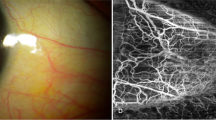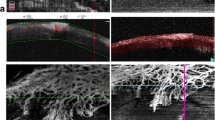Abstract
Purpose
Recently, optical coherence tomography angiography (OCTA) has been used to successfully delineate vessels within the retina. This current study aims to assess corneal vascularization secondary to herpetic keratitis pre- and post-treatment using serial OCTA imaging adapted for the anterior segment.
Methods
All eyes were scanned using the split-spectrum amplitude decorrelation angiography (SSADA) algorithm on the AngioVue OCTA system (Optovue Inc. Fremont, CA, USA) with an anterior segment lens adapter. Multiple scans in the regions of interest (ROI) before and after treatment were analysed to assess change in corneal vascularization in response to each treatment modality.
Results
We analyzed a total of 12 OCTA scans in three eyes with corneal vascularization, comparing images pre- and 3 months post-treatment. We found that the OCTA was able to detect a significant decrease in area of vascularization in all eyes: including fine-needle diathermy (48 ± 7 to 41 ± 5 %, P = 0.048), subconjunctival bevacizumab (45 ± 7 to 38 ± 5 %, P = 0.015) and systemic steroid treatment following graft rejection (38 ± 1 to 32 ± 2 %, P = 0.003).
Conclusions
Our preliminary study of serial OCTA scans suggests that this may be a useful tool for objective quantification of corneal vascularization. Future development of image processing software will be needed for clinical use or trials to evaluate anti-vascular therapies.

Similar content being viewed by others
Explore related subjects
Discover the latest articles and news from researchers in related subjects, suggested using machine learning.References
Spaide RF, Klancnik JM, Cooney MJ (2015) Retinal vascular layers imaged by fluorescein angiography and optical coherence tomography angiography. JAMA Ophthalmol 133:45–50. doi:10.1001/jamaophthalmol.2014.3616
Qazi Y, Maddula S, Ambati BK (2009) Mediators of ocular angiogenesis. J Genet 88:495–515
Lee P, Wang CC, Adamis AP (1998) Ocular neovascularization: an epidemiologic review. Surv Ophthalmol 43:245–269
Ang M, Mehta JS, Sng CC, Htoon HM, Tan DT (2012) Indications, outcomes, and risk factors for failure in tectonic keratoplasty. Ophthalmology 119:1311–1319. doi:10.1016/j.ophtha.2012.01.021
Cursiefen C, Colin J, Dana R, Diaz-Llopis M, Faraj LA, Garcia-Delpech S, Geerling G, Price FW, Remeijer L, Rouse BT, Seitz B, Udaondo P, Meller D, Dua H (2012) Consensus statement on indications for anti-angiogenic therapy in the management of corneal diseases associated with neovascularisation: outcome of an expert roundtable. Br J Ophthalmol 96:3–9. doi:10.1136/bjo.2011.204701
Ang M, Cai Y, MacPhee B, Sim DA, Keane PA, Sng CC, Egan CA, Tufail A, Larkin DF, Wilkins MR (2016) Optical coherence tomography angiography and indocyanine green angiography for corneal vascularisation. Br J Ophthalmol. doi:10.1136/bjophthalmol-2015-307706
Ang M, Sim DA, Keane PA, Sng CC, Egan CA, Tufail A, Wilkins MR (2015) Optical coherence tomography angiography for anterior segment vasculature imaging. Ophthalmology 122:1740–1747. doi:10.1016/j.ophtha.2015.05.017
Hsu CC, Chang HM, Lin TC, Hung KH, Chien KH, Chen SY, Chen SN, Chen YT (2015) Corneal neovascularization and contemporary antiangiogenic therapeutics. J Chin Med Assoc 78:323–330. doi:10.1016/j.jcma.2014.10.002
Gonzalez L, Loza RJ, Han KY, Sunoqrot S, Cunningham C, Purta P, Drake J, Jain S, Hong S, Chang JH (2013) Nanotechnology in corneal neovascularization therapy—a review. J Ocul Pharmacol Ther 29:124–134. doi:10.1089/jop.2012.0158
Ang M, Cai Y, Shahipasand S, Sim DA, Keane PA, Sng CC, Egan CA, Tufail A, Wilkins MR (2015) En face optical coherence tomography angiography for corneal neovascularisation. Br J Ophthalmol. doi:10.1136/bjophthalmol-2015-307338
Sharma A, Bettis DI, Cowden JW, Mohan RR (2010) Localization of angiotensin converting enzyme in rabbit cornea and its role in controlling corneal angiogenesis in vivo. Mol Vis 16:720–728
Zheng Y, Kaye AE, Boker A, Stewart RK, Tey A, Ahmad S, Willoughby CE, Bron AJ, Kaye SB (2013) Marginal corneal vascular arcades. Invest Ophthalmol Vis Sci 54:7470–7477. doi:10.1167/iovs.13-12614
Spiteri N, Romano V, Zheng Y, Yadav S, Dwivedi R, Chen J, Ahmad S, Willoughby CE, Kaye SB (2015) Corneal angiography for guiding and evaluating fine-needle diathermy treatment of corneal neovascularization. Ophthalmology 122:1079–1084. doi:10.1016/j.ophtha.2015.02.012
Petsoglou C, Balaggan KS, Dart JK, Bunce C, Xing W, Ali RR, Tuft SJ (2013) Subconjunctival bevacizumab induces regression of corneal neovascularisation: a pilot randomised placebo-controlled double-masked trial. Br J Ophthalmol 97:28–32. doi:10.1136/bjophthalmol-2012-302137
Papathanassiou M, Theodoropoulou S, Analitis A, Tzonou A, Theodossiadis PG (2013) Vascular endothelial growth factor inhibitors for treatment of corneal neovascularization: a meta-analysis. Cornea 32:435–444. doi:10.1097/ICO.0b013e3182542613
Ang M, Mehta JS, Arundhati A, Tan DT (2009) Anterior lamellar keratoplasty over penetrating keratoplasty for optical, therapeutic, and tectonic indications: a case series. Am J Ophthalmol 147(697–702):e692. doi:10.1016/j.ajo.2008.10.002
Kirwan RP, Zheng Y, Tey A, Anijeet D, Sueke H, Kaye SB (2012) Quantifying changes in corneal neovascularization using fluorescein and indocyanine green angiography. Am J Ophthalmol 154:850–858.e852. doi:10.1016/j.ajo.2012.04.021
Nieuwenhuizen J, Watson PG, Emmanouilidis-van der Spek K, Keunen JE, Jager MJ (2003) The value of combining anterior segment fluorescein angiography with indocyanine green angiography in scleral inflammation. Ophthalmology 110:1653–1666. doi:10.1016/S0161-6420(03)00487-1
Watson PG, Bovey E (1985) Anterior segment fluorescein angiography in the diagnosis of scleral inflammation. Ophthalmology 92:1–11
Chan CM, Chew PT, Alsagoff Z, Wong JS, Tan DT (2001) Vascular patterns in pterygium and conjunctival autografting: a pilot study using indocyanine green anterior segment angiography. Br J Ophthalmol 85:350–353
Kim YJ, Yoo SH, Chung JK (2014) Reconstruction of the limbal vasculature after limbal-conjunctival autograft transplantation in pterygium surgery: an angiography study. Invest Ophthalmol Vis Sci 55:7925–7933. doi:10.1167/iovs.14-15288
Conrad TJ, Chandler DB, Corless JM, Klintworth GK (1994) In vivo measurement of corneal angiogenesis with video data acquisition and computerized image analysis. Lab Invest 70:426–434
Girard MJ, Ang M, Chung CW, Farook M, Strouthidis N, Mehta JS, Mari JM (2015) Enhancement of corneal visibility in optical coherence tomography images using corneal adaptive compensation. Transl Vis Sci Technol 4:3. doi:10.1167/tvst.4.3.3
Bock F, Onderka J, Hos D, Horn F, Martus P, Cursiefen C (2008) Improved semiautomatic method for morphometry of angiogenesis and lymphangiogenesis in corneal flatmounts. Exp Eye Res 87:462–470. doi:10.1016/j.exer.2008.08.007
Bock F, Konig Y, Kruse F, Baier M, Cursiefen C (2008) Bevacizumab (Avastin) eye drops inhibit corneal neovascularization. Graefes Arch Clin Exp Ophthalmol 246:281–284. doi:10.1007/s00417-007-0684-4
Cursiefen C, Bock F, Horn FK, Kruse FE, Seitz B, Borderie V, Früh B, Thiel MA, Wilhelm F, Geudelin B, Descohand I, Steuhl KP, Hahn A, Meller D (2009) GS-101 antisense oligonucleotide eye drops inhibit corneal neovascularization: interim results of a randomized phase II trial. Ophthalmology 116:1630–1637. doi:10.1016/j.ophtha.2009.04.016
Ang M, Chong W, Huang H, Tay WT, Wong TY, He MG, Aung T, Mehta JS (2013) Comparison of anterior segment optical tomography parameters measured using a semi-automatic software to standard clinical instruments. PLoS One 8:e65559. doi:10.1371/journal.pone.0065559
Ang M, Sng C, Milea D (2016) Optical coherence tomography angiography in dural carotid-cavernous sinus fistula. BMC Ophthalmol 16:93. doi:10.1186/s12886-016-0278-1
Author information
Authors and Affiliations
Corresponding author
Ethics declarations
Funding
Singhealth Research Foundation (R1275/81/2015)
Conflict of interest
All authors certify that they have no affiliations with or involvement in any organization or entity with any financial interest (such as honoraria; educational grants; participation in speakers’ bureaus; membership, employment, consultancies, stock ownership, or other equity interest; and expert testimony or patent-licensing arrangements), or non-financial interest (such as personal or professional relationships, affiliations, knowledge or beliefs) in the subject matter or materials discussed in this manuscript.
Ethical approval
All procedures performed in studies involving human participants were in accordance with the ethical standards of the institutional and/or national research committee and with the 1964 Helsinki declaration and its later amendments or comparable ethical standards.
Informed consent
Informed consent was obtained from all individual participants included in the study.
Rights and permissions
About this article
Cite this article
Cai, Y., Alio del Barrio, J.L., Wilkins, M.R. et al. Serial optical coherence tomography angiography for corneal vascularization. Graefes Arch Clin Exp Ophthalmol 255, 135–139 (2017). https://doi.org/10.1007/s00417-016-3505-9
Received:
Revised:
Accepted:
Published:
Issue Date:
DOI: https://doi.org/10.1007/s00417-016-3505-9




